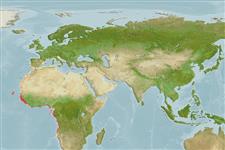Classificação / Names
Common names from other countries
Referência principal
Tamanho / Peso / Idade
Max length : 100.0 cm TL macho/indeterminado; (Ref. 2683); 98.0 cm FL (female); common length : 75.0 cm TL macho/indeterminado; (Ref. 2683); Peso máx. publicado: 6.0 kg (Ref. 40637); Idade máx. registada: 5 anos (Ref. 27160)
Length at first maturity
Lm 37.3, range 33 - 45 cm
Ambiente
; marinhas; estuarina; oceanódromo (Ref. 51243); intervalo de profundidade 1 - 40 m (Ref. 28173), usually 20 - 25 m (Ref. 28173)
Clima / Intervalo
Tropical, preferred 24°C (Ref. 107945); 45°N - 19°S, 24°W - 14°E (Ref. 168)
Distribuição
Eastern Atlantic: Canary Islands and Senegal to the Gulf of Guinea and Baía dos Tigres, Angola. Rarely found in the northern Mediterranean Sea, along the coasts of France and Italy. This species has been erroneously been considered as a synonym of Scomberomorus maculatus by many authors.
Países | Áreas FAO | Ecossistemas | Ocorrências | Introduções
Descrição breve
Espinhos dorsais (total): 15 - 18; Raios dorsais moles (total): 0; Raios anais moles: 17 - 20; Vértebras: 46 - 47. Interpelvic process small and bifid. Body covered with small scales. Lateral line gradually curving down toward caudal peduncle. Intestine with 2 folds and 3 limbs. Swim bladder absent. Some large individuals with thin vertical bars. Anterior half of first dorsal fin and margin of posterior half of first fin black.
Categoria na Lista Vermelha da IUCN (Ref. 115185)
Ameaça para o homem
Harmless
Utilização humana
Pescarias: espécies comerciais
Mais informação
ReferênciasAquaculturaPerfil para aquaculturaEstirpesGenéticaFrequência dos alelosHereditariedadeDoençasProcessamentoMass conversion
ColaboradoresFotografiasStamps, CoinsSonsCiguateraVelocidadeTipo de nataçãoÁrea branquialOutras referênciasCérebrosVisão
Ferramentas
Relatórios especiais
Descarregue XML
Fontes da internet
Estimates of some properties based on models
Phylogenetic diversity index
PD50 = 0.5000 many relatives (e.g. carps) 0.5 - 2.0 few relatives (e.g. lungfishes)
Nível Trófico
4.3 ±0.74 se; Based on food items.
Resiliência
Médio, tempo mínimo de duplicação da população 1,4 - 4,4 anos (K=0.31-0.33; tmax=5; Fec=1 million)
Vulnerabilidade
Moderate vulnerability (38 of 100)
Categoria de preço
